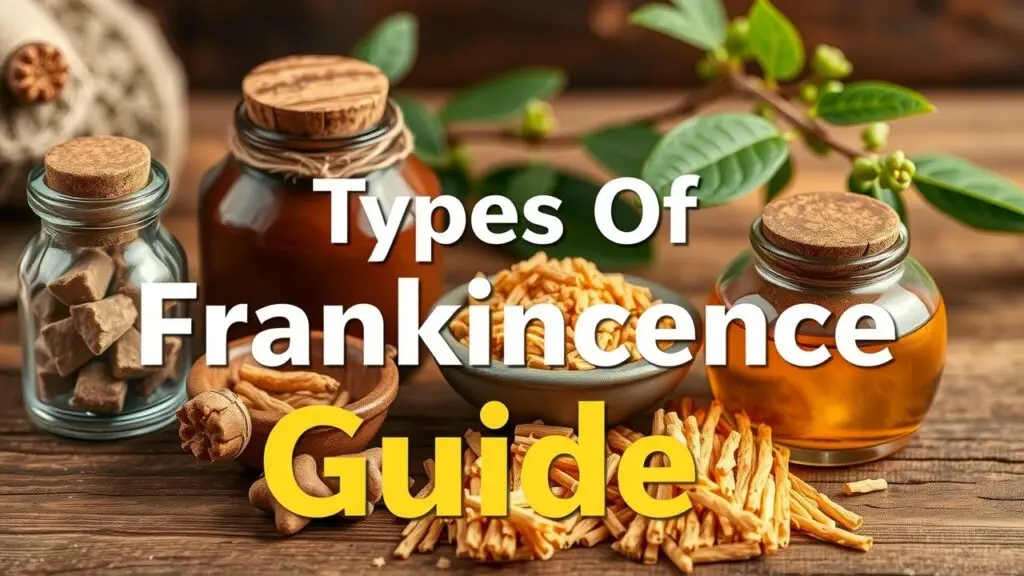Types of frankincense vary greatly, with popular choices including Frankincense Sacra and Carterii. This guide explores these and other types, detailing their unique properties and uses as essential oils and resins.
What is Frankincense?

Frankincense is a sweet-smelling resin from the Boswellia trees. These trees are part of the Boswellia genus. Some popular species are Boswellia sacra, Boswellia carterii, and Boswellia frereana. Each type has unique qualities that make them special. This resin has been used for ages in different cultures, valued for both its healing properties and spiritual meanings.
To get frankincense, workers cut the bark of the tree. This allows the sap to flow out and harden into small lumps or tears. You can find frankincense in various forms, such as raw resin, essential oil, or incense sticks. When buying, it’s best to choose organic frankincense labeled as 100% pure so you can enjoy all its benefits.
Brief History and Cultural Significance
Frankincense has a fascinating past that goes back thousands of years. In ancient Egypt, it was precious and used in religious ceremonies and embalming because of its preserving qualities. In the Bible, frankincense was one of the gifts brought to Jesus by the Magi (Matthew 2:11). This highlights its value in religious traditions.
Many cultures have also used frankincense in their spiritual practices. It symbolizes purity and divinity in rituals from Hinduism to Christianity. Beyond spiritual uses, ancient people also turned to frankincense for medicine.
Why Different Types Matter?
Knowing about the different types of frankincense is key when picking what you need. Each variety offers different scents, colors, and uses.
Here’s a quick look at some common types:
- Boswellia sacra: Has a sweet scent with citrus notes. Good for aromatherapy and spiritual practices.
- Boswellia carterii: Offers an earthy aroma with woody hints. Commonly used for skin care and meditation.
- Boswellia frereana: Features a spicy scent with lemon undertones. Often used in incense and traditional medicine.
Different types may have varying healing effects too, like reducing inflammation or boosting mood. So it helps to know which type fits your needs best—whether you’re looking for something for aromatherapy or skin care.
Understanding these differences can help you make smart choices about which kind of frankincense you want while appreciating its rich history and cultural importance.
Key Frankincense Species and Their Origins
Frankincense comes from the resin of Boswellia trees. It’s been cherished for many years in different cultures for its pleasant scent and healing properties. Let’s take a closer look at the main types of frankincense and where they come from.
Boswellia sacra (Hojari Frankincense)
- Origin: This type mainly comes from Oman.
- Harvesting Methods: Hojari frankincense is gathered using traditional tapping methods. These techniques help keep the tree healthy while producing high-quality resin.
- Unique Characteristics: It is known for its sweet smell and excellent resin quality. Many people consider it one of the best kinds available.
Boswellia carterii (Indian Frankincense)
- Origin: This variety comes from India and Somalia.
- Distinguishing Features: Indian frankincense is popular in making incense. It has a warm scent with spicy notes, making it a favorite among those who love rich aromas.
Boswellia frereana (African Frankincense)
- Origin: It is primarily found in Somalia and Ethiopia.
- Characteristic Aroma and Appearance: African frankincense offers a sweet, rich aroma. People often call it “Maydi” or simply “frankinsence,” setting it apart from other types.
Boswellia papyrifera (Egyptian Frankincense)
- Origin: This variety comes from Ethiopia and Sudan.
- Historical and Current Uses: Egyptian frankincense has been used in ancient rituals for centuries. It is valued today for its calming effects.
Other Notable Boswellia Species
Brief Overview of Less Common Varieties
- Boswellia serrata: Mostly found in India, this type is known for helping with inflammation, making it useful both for its scent and health benefits.
- Boswellica thurifera: This species grows mainly in the Middle East and has a unique fragrance that appeals to many essential oil fans.
In summary, each type of frankincense brings its own unique characteristics and uses. Whether you’re drawn to the sweet scent of Hojari or the calming properties of Egyptian frankincense, there’s a variety for everyone to enjoy!
Frankincense Aroma Profiles: A Sensory Exploration
Detailed Aroma Descriptions for Each Species
Frankincense comes from the resin of Boswellia trees, and its aroma can change depending on the species. The main types are Boswellia sacra, Boswellia carterii, and Boswellia frereana.
- Boswellia sacra has a sweet and citrusy scent, with some spicy notes. Many people choose this type for aromatherapy because it can lift the mood.
- Boswellia carterii offers an earthy aroma with warm undertones. This variety is popular for meditation and spiritual practices because it helps people relax.
- Boswellia frereana, often called “Hojari,” provides a rich and complex fragrance. It combines sweetness with woody notes, making it highly sought after for incense and essential oils.
These unique scents enhance spaces and play important roles in various cultural rituals.
How Terroir and Harvesting Affect Aroma?
The aroma of frankincense can change based on where it’s grown and how it’s harvested.
Organic farming leads to better quality resins because no synthetic fertilizers or pesticides are used. This keeps the natural scent profile intact. Sustainable harvesting methods ensure that trees are not over-tapped, which helps them produce resin without harming their health.
Different regions create unique characteristics due to soil types, climate differences, and local plant interactions. For instance, frankincense from Oman may have different notes than that from Somalia.
Understanding these differences helps you pick the right kind of frankincense based on your needs while appreciating its full sensory potential.
Chemical Composition and Therapeutic Properties
Key Chemical Components
Frankincense comes from the resin of Boswellia trees. It has many chemical components that give it special qualities. The main ingredients include terpenes like alpha-pinene and limonene. These terpenes are known for their nice smells and potential health benefits. Another important compound is incensole acetate, which adds to the therapeutic effects of frankincense oil.
The chemical makeup can be divided into two groups: monoterpenes and sesquiterpenes. Monoterpenes, like alpha-pinene, have fresh scents and may help reduce inflammation. Sesquiterpenes help promote relaxation and may improve emotional health. Knowing about these components helps people understand the different types of frankincense available today.
Potential Therapeutic Benefits
Frankincense is known for its many therapeutic benefits due to its rich chemical profile. It may have anti-inflammatory properties that could help with conditions like arthritis or other inflammatory issues. Its antimicrobial traits make it useful for skin health, as it can fight bacteria and fungi.
Additionally, frankincense has antioxidant qualities that protect cells from damage caused by free radicals. Many people turn to high-quality frankincense oils as natural remedies for things like respiratory problems or anxiety relief during meditation because of their calming effects.
Scientific Studies Supporting Benefits
Many studies support the claims about frankincense’s health benefits. For example, research on Boswellia serrata, a common type used in traditional medicine, shows that it can effectively reduce inflammation and manage pain.
These studies help us understand how various types of frankincense can be used based on their specific makeups and related health benefits.
Frankincense Resin Grades and Quality
Factors Determining Grade
The grade of frankincense depends on a few key factors. First, color matters. Frankincense resin can range from light yellow to dark brown. Typically, lighter resins are seen as higher quality. They tend to be purer and more fragrant.
Next is aroma quality. High-quality frankincense often has a rich scent that changes as it burns or is used in a diffuser. In contrast, low-grade options might have a flat smell without much depth.
Harvesting methods also affect the resin’s quality. Sustainable harvesting practices help protect the trees and ensure better resin production over time. Organic frankincense, taken from well-managed forests, usually has better aroma and purity compared to those gathered unethically.
How Grade Impacts Price and Quality?
There’s a strong link between frankincense grade and its price in the market. Higher grades cost more because they offer better qualities like richer aromas and higher purity levels.
For instance, Boswellia sacra is one of the most prized species, especially from Oman. Its high-quality varieties can be quite expensive compared to lower-grade species like Boswellia carterii or Boswellia serrata, which might lack the same aromatic richness.
| Boswellia Species | Typical Price Range (per ounce) | Quality Characteristics |
|---|---|---|
| Boswellia sacra | $20 – $50 | Rich aroma; high therapeutic value |
| Boswellia carterii | $10 – $30 | Moderate aroma; versatile use |
| Boswellia serrata | $5 – $15 | Milder scent; commonly used |
Identifying High-Quality Frankincense
To spot high-quality frankincense, consumers should check a few things. The resin should look like large tears instead of small bits or powder.
Also, pure frankincense oil must pass authenticity tests like Gas Chromatography-Mass Spectrometry (GC/MS). This testing checks its chemical makeup against known purity standards. Consumers should buy from suppliers who show transparency about their sourcing processes and provide lab results that confirm product integrity.
Common Misconceptions About Frankincense Grades
There are many myths about frankincense grades. A common belief is that darker resins are always of lower quality. However, some darker varieties can have unique aromas that people find appealing.
Another misconception involves pricing: higher prices often suggest better quality because they come from rare sources or require careful harvesting techniques, but this isn’t always true for everyone’s taste preferences.
Importance of Ethical Sourcing in Quality Assessment
Ethical sourcing is crucial when looking at the quality of boswellia species resins. Sustainable farming practices protect the environment while also helping local communities thrive. Supporting ethically sourced products ensures everyone involved in the process benefits fairly and maintains biodiversity.
Choosing the Right Frankincense for Your Needs
Frankincense comes from the Boswellia tree and has many types. Each type serves different purposes. Knowing about these types helps you pick the best frankincense for your needs, whether it’s for aromatherapy, incense burning, skincare, spiritual practices, or budget concerns.
Considerations for Aromatherapy
When you choose frankincense for aromatherapy, think about what smells good to you and what effects you want. Popular choices are Boswellia carterii and Boswellia sacra.
- Boswellia carterii has a sweet, woody scent that helps with relaxation and stress relief.
- Boswellia sacra is often considered high quality due to its rich scent. It can help with mental clarity and boost your immune system.
For making essential oil blends:
- Mix frankincense with lavender or bergamot for a calming effect.
- Combine it with citrus oils like lemon or orange to lift your mood.
Trying different blends can help you find what works best for your wellness goals.
Considerations for Incense
Choosing frankincense for burning as incense involves knowing how each type can enhance meditation or spiritual practices. Some popular resins include:
| Type | Aroma Profile | Best For |
|---|---|---|
| Boswellia serrata | Earthy & spicy | Grounding during meditation |
| Boswellia frereana | Sweet & floral | Creating a calming atmosphere |
Burning these resins helps set a peaceful environment. When picking incense resin, check its purity (look for organic options) and where it comes from since these factors impact quality and scent.
Considerations for Skincare
Using frankincense in skincare has many potential benefits due to its anti-inflammatory properties. Different types may suit various skin issues:
- Boswellia carterii is great for dry skin since it helps keep moisture.
- Boswellia sacra works well on mature skin by helping maintain elasticity.
To apply frankincense oil:
- Mix it with a carrier oil like jojoba or coconut oil before using it on your skin.
- Apply it directly on spots needing attention—like scars or blemishes—for possible healing benefits.
Using it regularly might improve skin texture while avoiding irritation from harsh chemicals found in some products.
Considerations for Spiritual Practices
Different kinds of frankincense have been used in religious ceremonies across many cultures:
- Olibanum, a name often linked to certain types of frankincense (especially from Somalia), is significant in Christian rituals.
Personal preferences matter here; people often choose based on historical significance within their faith or what feels right spiritually during their practices at home.
Budget Considerations
The price of various types of frankincense can differ quite a bit based on quality and source.
While higher prices usually mean better quality—often linked to purity—it’s still possible to find good options that won’t break the bank if you know where to look (like specialty shops focusing on natural products).
By thinking about all these factors—from scents suited to personal needs to money limits—you can confidently select the right type of frankincense just right!
Safe Handling and Usage of Frankincense
When using frankincense, safety is key. This aromatic resin is known for its therapeutic benefits. Knowing how to use it right can enhance your experience and keep you safe.
Proper Storage
To keep frankincense fresh, store it properly. Use an airtight container to protect its aroma and strength. Air exposure can cause oxidation, which weakens its effects over time. Keep the container away from light and moisture; both can harm the resin’s quality. A cool, dark place works best for high-quality frankincense.
Safe Handling Practices
When using pure frankincense oil or incense, follow these safe handling tips:
- If applying essential oils to your skin, always dilute them with a carrier oil first. This helps avoid skin irritation. Common carrier oils include coconut oil and jojoba oil.
- When burning incense sticks or resins, make sure there’s good ventilation in the room. This helps reduce smoke inhalation risks and keeps air clean.
Potential Precautions and Contraindications
Some precautions are important when using frankincense:
- Pregnant women should talk to a healthcare professional before using any type of frankincense. There may be effects on pregnancy health.
- Breastfeeding mothers should also seek advice about using essential oils while nursing.
- Allergies could happen with certain boswellia species found in different types of frankincense. If you have sensitive skin or known allergies, do a patch test before applying it topically.
Frequently Asked Questions about Frankincense
What are the main benefits of frankincense?
Frankincense has many benefits. It can act as an antibacterial and antiseptic. It may also relieve pain and inflammation, aiding conditions like arthritis. Users often find it helpful for anxiety and stress relief.
How does frankincense support skin health?
Frankincense oil is great for skincare. It may help with anti-aging, reducing the appearance of fine lines. This oil can also soothe irritated skin and promote a more youthful look.
What types of frankincense are best for aromatherapy?
For aromatherapy, Boswellia sacra is often preferred. It has a sweet aroma that uplifts mood. Boswellia carterii is another good choice for relaxation during meditation.
Can frankincense aid in respiratory health?
Yes, frankincense can support respiratory health. It acts as a decongestant and may help clear airways. Inhaling its aroma can ease breathing issues.
How should I use frankincense essential oil safely?
Always dilute frankincense essential oil with a carrier oil before applying it to the skin. This helps prevent irritation. Perform a patch test to check for allergic reactions.
Additional Insights on Frankincense Varieties
- Boswellia Serrata: Known for its anti-inflammatory properties, this type can reduce swelling.
- Boswellia Frereana: Often referred to as African frankincense, it’s prized for its rich aroma.
- Chemical Composition: Frankincense contains α-pinene and incensole acetate, contributing to its therapeutic effects.
- Cultural Uses: Frankincense has played significant roles in religious ceremonies across cultures, including biblical times.
- Harvesting Practices: Sustainable farming methods enhance the purity of frankincense while supporting local communities.
- Market Availability: You can find high-quality frankincense through reputable online retailers and specialty shops.
- Purity Testing: Ensure your product has a GC/MS report to confirm its authenticity.
- Blending Possibilities: Frankincense blends well with other essential oils like lavender and citrus for enhanced benefits.
- Potential Side Effects: Some individuals may experience allergies or irritations; consult with a healthcare provider if unsure.
These points cover various aspects of frankincense varieties and their uses in daily life while emphasizing sustainability and quality sourcing.
Related Topics
- types of boswellia trees
- types of frankincense resin grades
- types of frankincense aroma profiles
- types of frankincense essential oils
- types of frankincense harvesting methods
- types of frankincense uses
- types of frankincense suppliers



Types of Frankincense: A Guide to Frankincense Sacra, Carterii, & More